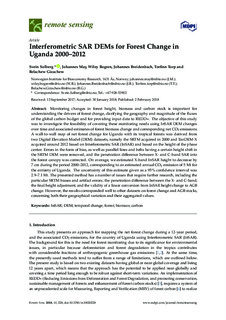| dc.contributor.author | Solberg, Svein | |
| dc.contributor.author | May, Johannes | |
| dc.contributor.author | Bogren, Wiley Steven | |
| dc.contributor.author | Breidenbach, Johannes | |
| dc.contributor.author | Torp, Torfinn | |
| dc.contributor.author | Gizachew, Belachew | |
| dc.coverage.spatial | Uganda | nb_NO |
| dc.date.accessioned | 2018-09-14T11:04:18Z | |
| dc.date.available | 2018-09-14T11:04:18Z | |
| dc.date.created | 2018-04-17T13:55:47Z | |
| dc.date.issued | 2018-02-02 | |
| dc.identifier.citation | Remote Sensing. 2018, 10 (2), . | nb_NO |
| dc.identifier.issn | 2072-4292 | |
| dc.identifier.uri | http://hdl.handle.net/11250/2562668 | |
| dc.description.abstract | Monitoring changes in forest height, biomass and carbon stock is important for understanding the drivers of forest change, clarifying the geography and magnitude of the fluxes of the global carbon budget and for providing input data to REDD+. The objective of this study was to investigate the feasibility of covering these monitoring needs using InSAR DEM changes over time and associated estimates of forest biomass change and corresponding net CO2 emissions. A wall-to-wall map of net forest change for Uganda with its tropical forests was derived from two Digital Elevation Model (DEM) datasets, namely the SRTM acquired in 2000 and TanDEM-X acquired around 2012 based on Interferometric SAR (InSAR) and based on the height of the phase center. Errors in the form of bias, as well as parallel lines and belts having a certain height shift in the SRTM DEM were removed, and the penetration difference between X- and C-band SAR into the forest canopy was corrected. On average, we estimated X-band InSAR height to decrease by 7 cm during the period 2000–2012, corresponding to an estimated annual CO2 emission of 5 Mt for the entirety of Uganda. The uncertainty of this estimate given as a 95% confidence interval was 2.9–7.1 Mt. The presented method has a number of issues that require further research, including the particular SRTM biases and artifact errors; the penetration difference between the X- and C-band; the final height adjustment; and the validity of a linear conversion from InSAR height change to AGB change. However, the results corresponded well to other datasets on forest change and AGB stocks, concerning both their geographical variation and their aggregated values. | nb_NO |
| dc.language.iso | eng | nb_NO |
| dc.rights | Navngivelse 4.0 Internasjonal | * |
| dc.rights.uri | http://creativecommons.org/licenses/by/4.0/deed.no | * |
| dc.subject | Forest change | nb_NO |
| dc.title | Interferometric SAR DEMs for Forest Change in Uganda 2000–2012 | nb_NO |
| dc.type | Journal article | nb_NO |
| dc.type | Peer reviewed | nb_NO |
| dc.description.version | publishedVersion | nb_NO |
| dc.rights.holder | © 2018 by the authors. | nb_NO |
| dc.subject.nsi | VDP::Landbruks- og Fiskerifag: 900::Landbruksfag: 910::Skogbruk: 915 | nb_NO |
| dc.source.pagenumber | 17 | nb_NO |
| dc.source.volume | 10 | nb_NO |
| dc.source.journal | Remote Sensing | nb_NO |
| dc.source.issue | 2 | nb_NO |
| dc.identifier.doi | 10.3390/rs10020228 | |
| dc.identifier.cristin | 1579825 | |
| dc.relation.project | Norges forskningsråd: 248925 | nb_NO |
| cristin.ispublished | true | |
| cristin.fulltext | original | |
| cristin.qualitycode | 1 | |

